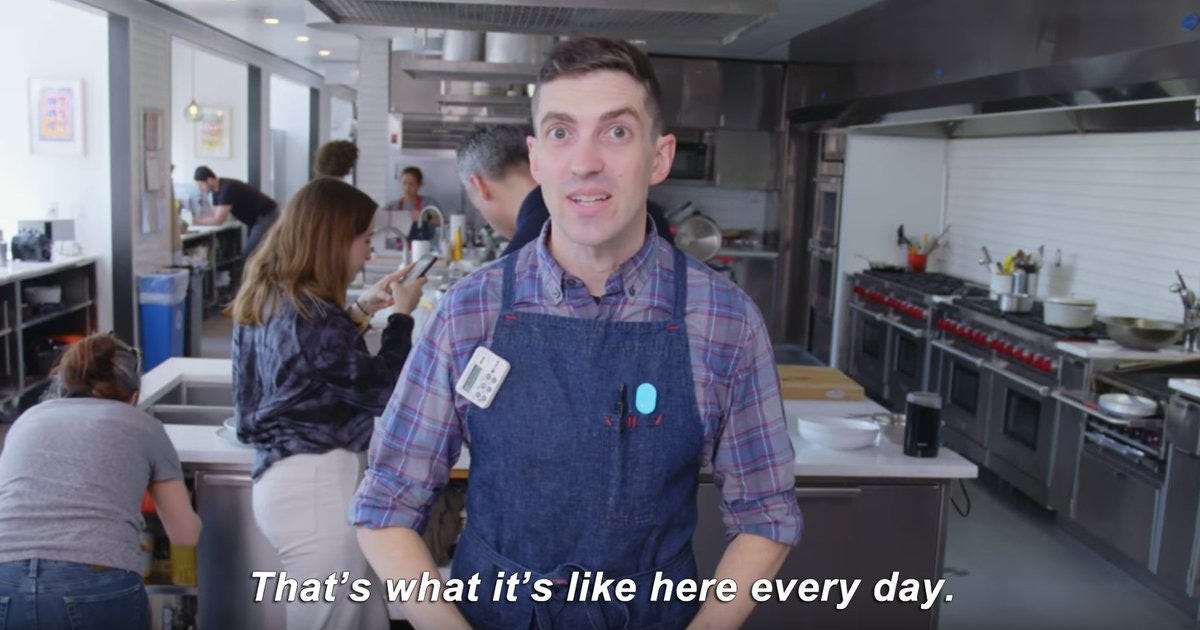Hello. Thanks for being here.
This is In Digestion, a weekly survey of the best food media on the web, and why you should care about it. If you like this newsletter, please follow @in_digestion and @jameskhansen on Twitter, and forward it to a large number of people. It should feel like too many. It won’t be enough. Thank you.
I think we know what this is about! Roll it.
Sruthi Pinnamaneni opens the second chapter of Reply All’s investigation into Bon Appétit with a quiet howitzer: “The reason I find Bon Appétit worth talking about is not because it’s unusual, but because so much of what went wrong there is fairly typical.” Each space — the Test Kitchen that gives the series its title, the pitch room that feels like it overhangs an entire city, the glass citadel of cool — is given fine detail by the testimony of former employees of colour, forced to contort themselves by “Nice White People” who didn’t give a second thought to their interiority. “While Jesse [Sparks] had spent years studying how he might fit into a place like Condé, Condé had not spent years wondering how they might accommodate Jesse.” Disclosure: Jesse is now a colleague at Eater. Chapter two also highlights both the empathy and analysis of Pinnameni’s narrative device in chapter one, describing Adam Rapoport’s “hire buddies” attitude as “an original sin.” To diagnose the harm done to its employees and readers of colour by Bon Appétit as something rotten or broken is only half the story; it was a system built with intention working as designed. Pair with a piece featured in the third edition of this newsletter — Tunde Wey asking Helen Rosner, the New Yorker, and everybody else: “can you renovate a burning house?”
Thank you to Vittles and Whetstone for delivering one of the greatest joys for an aggregation nerd — two pieces which shine light on each other’s multitudes published within days of each other. Vidya Balachander and Natasha Amar respectively historicise the presence of karak in Dubai via migration, yes; they establish the motifs of a drink made democratic by price, yes. But what they do best is complicating all of these things — for Amar, by highlighting the pressures of modernity and competition; for Balachander, in introducing the variousness of Dubai’s snack-and-sandwich culture — putting pressure on the the foundations of their own stories to tell deeper ones still. Rahanna Bisseret Martinez’s story on the “pliable comforts of agua de jamaica” for Taste would be another to refract these complications through.
Maryam Jillani’s Goya Journal essay on the evolution and proliferation of Shinwari cuisine continues on the theme of complicating one’s own ideas to reinforce them. The diffusion of Shinwari food and its becoming a metonym for the Pashtun cooking of which it is one tiny part is the focus, with Jillani exploring both the techniques behind its banner dishes and the cultural and geopolitical reasons for their proliferation. Annemarie Evans’ piece on the multiplicities of Hakka cooking traditions in Hong Kong for Zolima City sits well here too.
Boredom snacking? Hard relate. Kaki Okumura lays it out.
The long-awaited Guy Fieri essay for paid subscribers will come out this week; the bleached-tips decided to complicate things further by opening a ton of ghost kitchen restaurants, which turn out to be very instructive for the misunderstanding of the misunderstanding of the misunderstanding of Guy Fieri. Hold tight.
That’s all for this week. Thank you for reading — oh, and please forward this to those three friends and one nemesis. Or just, like, everyone.



